OFF GRID COMMUNITY CONCEPT:
SUSTAINABLE LIVING & RENEWABLE ENERGY
Pilot Project: The “Off Grid Community Project” is the first stage of a multi-stage project which if successful could expand into a small self-sustaining community.
Concept: Build a sustainable living self-sufficient off-the-grid home system, which anyone can build for less than $100k, and open source the plans to the world. An “affordable” 1500-2500 sq ft open sourced natural material home, greenhouse, 5kw wind turbine, and a 5kw solar array, for less than $100k (crowdsourced home & community building)
UPDATE: $25k 1280 SQFT RANCH STYLE SHIPPING CONTAINER HOME
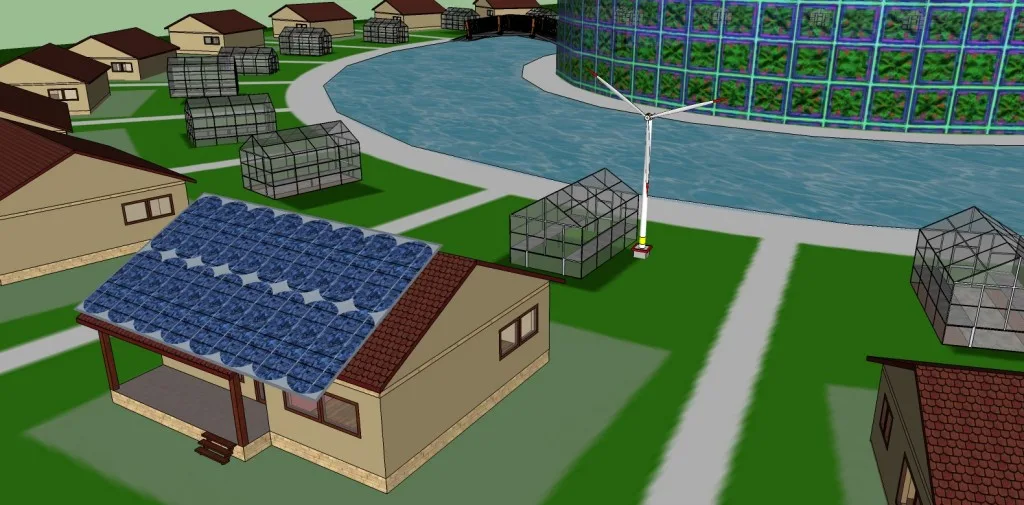
THE PROBLEM:
All over the world people cannot afford to live sustainably, much less comfortably. They cannot afford to buy a home, land, and the needed technology to make themselves and their families self-sufficient. Most people, if they are able to find employment, spend most of their time working just to pay bills, and can barely keep a roof over their heads and food on the table.
THE SOLUTION:
The idea isn’t just to build a house on a piece of land, but rather a whole system whereby a reasonably sized family can live comfortably, producing their own food and energy, enabling them to become self-sufficient. This has the added benefit of contributing food and energy to the community as well.
The energy efficient system is designed to combine current off-the-shelf technology which is proven and affordable, creating a hybrid system of living that provides the necessities, comforts, and some of the luxuries of traditional homes.
By combining proven technologies, the learning curve isn’t as great a hurdle, and you remove the troublesome burden of “reinventing the wheel”. Innovation can come “after” the system is built and there is time to think and ponder on how to improve the system.
People need a place to live and call home. Once they have that, they can think about the future. They need to secure themselves and their families first, making sure things are provided for their loved ones and themselves. The greatest part about this “off-the-shelf- hybrid system, is it will work. ALL technologies have been proven, tested, and people use them every day. The only difference with this idea is combining current technologies to form a completely self-sufficient and extensive living system.
Off grid community systems:
- 100% natural and recycled materials
- 100% off the grid sustainable living
- 100% “green” eco-friendly construction
- Either earthen structure, strawbale, cob, rammed earth, bamboo, compressed earth block, etc.
- Equip with 5-10kw wind turbine
- Equip with 5-10kw solar array
- Greenhouse: 1000-1500 square foot greenhouse for growing organic food year round, regardless of climate or location.
- Materials & design – strawbales, mud plaster, CEB (compressed earth brick) and/or, soy and corn-based building materials, recycled materials, bamboo, etc.
- Open source technologies: houses will be built using 100% Open Source technology
- BUILD IT FOR LESS THAN $100k – Including land, time, labor, equipment, permitting, and materials.
- Create a design that can be implemented for $50k complete with land and materials.
- Brainstorm about ways to do it for $25k or less
- Perhaps use cargo containers and strawbales for the building. This really lowers costs and provides insulation in cold or hot environments.
HOME: 320-2500 square foot home. Depending on material costs.
GREENHOUSE: For growing produce for consumption and for sale at local community farmers market.
DUAL NATURAL POWER SYSTEM:
- 5kw Wind Turbine: Produces enough electricity to power a small home
- 5kw Solar Panel Array: Produces enough electricity to power a small home
Participants & Building: The home will be built using mostly volunteer time, labor, equipment.
Partner with Manufacturers for discounted/free Building Materials:
Materials could be purchased at cost (or free) from ECOFRIENDLY MATERIAL MANUFACTURERS in exchange for their “partnership”. Benefits include becoming part of the “Open Source Home Project Team”, recognition of their giving on their own product page on this website, promoting their business, free publicity/advertising/exposure for their company, their participation helps to create a new kind of sustainable home system.
- Increase their company’s visibility
- Creates interest in their products and services
- Investment in the betterment of humanity, education, lifestyle, and progress
- Enhancement of business image
- Increased advertising opportunity
- Demonstrates concern for community issues
Open Sourced Building
House(s) would be built using as much open sourced labor, equipment, technology and software as possible.
- Open Source Home System
- Open Source Architecture
- Open Source Design
- Open Source Agriculture
Model Sold: When complete the house would be placed on the market and sold at near market value.
Profit Sharing: Profits (if any) would be split with the whole team.
—————
Phase I: Green Architecture Design Contest ($ prize)
Phase II: Design Selection & Modification
Phase III: Recruitment & Planning
Phase IV: Permitting
Phase V: The Build
Phase VI: The Sale
Phase VII: The Share (profit share or forming of residential/agricultural co-op)
TYPES OF CONSTRUCTION:
- Shipping Container Homes
- Geodesic Domes Houses
- Compressed Earth Brick
- Rammed Earth
- Straw Bale
- Cob
- Bamboo
———————————————————————————————-
Stage 2: After the pilot “Open Source Home Project”
OPEN FARM COMMUNITY PROJECT
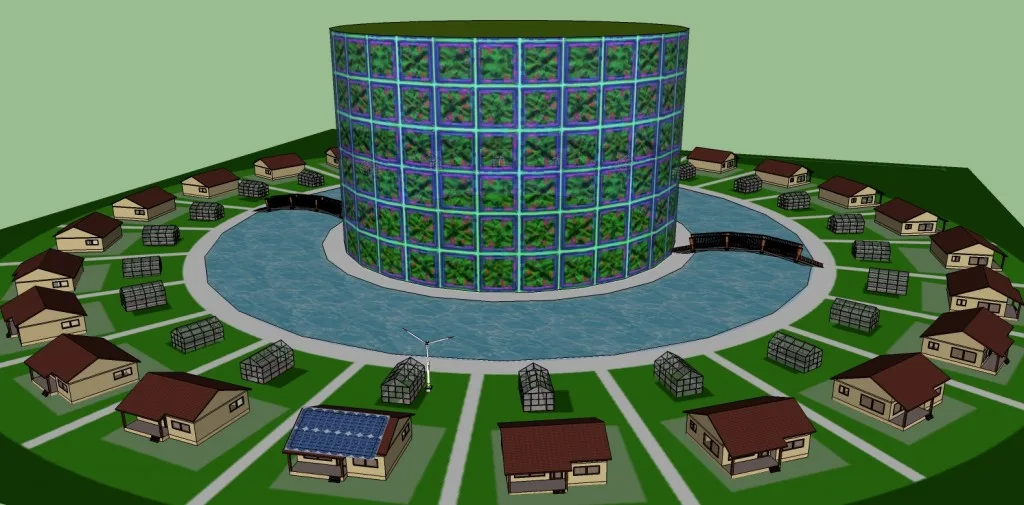
This is a simple 3D model of the concept of the open community project. This is an agriculture co-op community, using the above Open Source Home Project system, and expanding it into a full community farm project where residents are also owners in the farm and share in the proceeds of the farm revenue. It also doubles as a farmers market on weekends to provide revenue for community families.
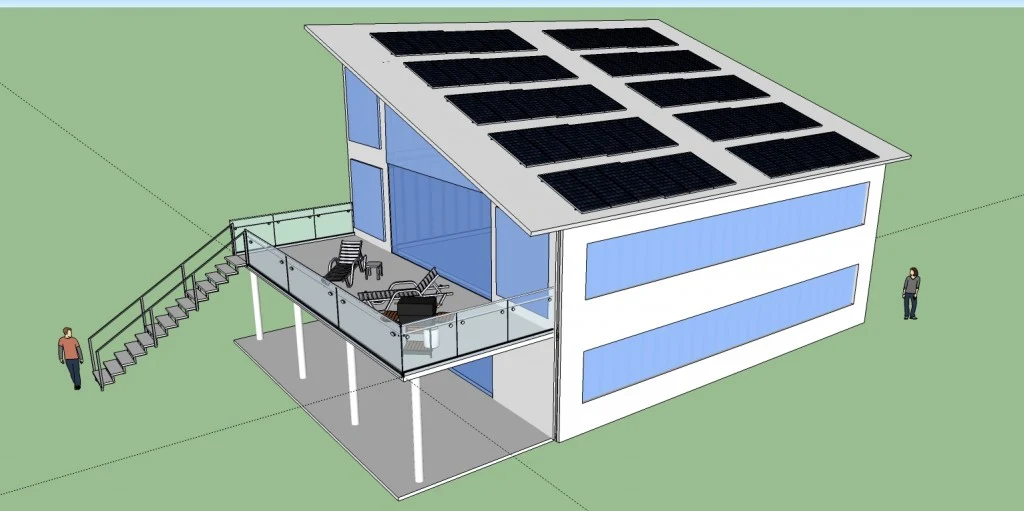
A shipping container home could be implemented in lieu of a traditional stick built house.
Since this is a co-op business, those families would be part owners in the residential/agriculture co-op which will function similarly to a CSA (community supported agriculture) farm.
A Hybrid Cooperative Farm/Community: The entire project is designed with community in mind. From residential, to agricultural, to business, the entire concept is energy efficient and all “units” function as a whole. Each home system acts as energy/food producers.
Cooperative Machine: It’s basically a bioecomachine generator, powering the farm through the cooperative sharing of energy produced by the home “units” which produce about 5-7 kilowatts of electricity per hour through the wind/solar 10kw power system. The average home in the United States uses about 1500 kilowatts of power each month.
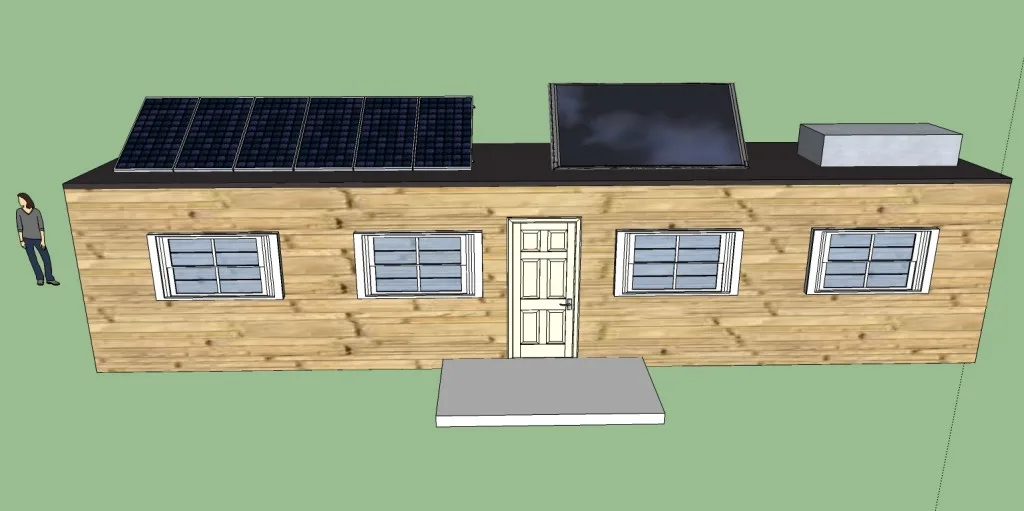
SOLAR POWER SYSTEM: There are 32 home systems. This equates to a whole system that will generate (at peak) approximately 160 kilowatts per hour at 50% efficiency. The community will be built in Southern California which has an average of 6 hours of good sunlight per day. On less sunny days, winds pick up, and the 5kw Wind Turbine will supplement energy generation.
- 32 home systems x 5kw = 160 kw per hour
- 6 hours x 160 kw per hour (at peak) = 960 kilowatts of electricity generation per day
- 960 kilowatts per day x 30 days = 28,800 kilowatts of electricity generation per month
If you want to take it further or think this isn’t enough power for 32 homes, keep in mind 33% of the time homes will probably be vacant because families will be out and about. That is 9504 kilowatts of electricity per month that can run the farm while houses are not in use.
This system (at roughly 50% efficiency) should produce ~960kw per day for the entire farm/community during daylight hours.
WIND POWER SYSTEM: Wind blows approximately 50% of the time in Southern California.
- 24 hours per day x 30 days = 720 hours per month / 2 = 360 hours of run time
- Figure 50% efficiency which cuts that number down to 180 hours of wind/generation time.
- 180 hours x 5kw = 900 kilowatts of power per month per unit
- 32 home systems x 900 kilowatts = 27,000 kilowatts per month
GREENHOUSE SYSTEM: There are 32 greenhouses on 32 lots. Each greenhouse is at least 1000-1200 square feet. This means there are 32,000-38,400 square feet of growing space to produce organic food crops, and specialty herbs, spices, and even include a small aquaponics system if the homeowner chooses.
The idea, of course, is a completely modular system which allows homeowner/community member to become 100% self-sufficient, as well as produce food. Excesses can be sold at the market.
WATER SYSTEM: Water could be produced by a community well, and/or a combination of a water collection system, lake/pond, and individual water collection.
ATMOSPHERIC WATER GENERATOR: Water production can also be supplemented by individual atmospheric water generators.
A water generator is a simple system that combines off-the-shelf technology (refrigerator) some copper tubing, vegetable oil, a charcoal filter, and two small DC water pumps to produce water through a condensation method and collects the water in sterilized water tanks. All parts should cost less than $1000 to build the unit. We’ll also store water in large tanks and/or reservoirs located throughout the community.
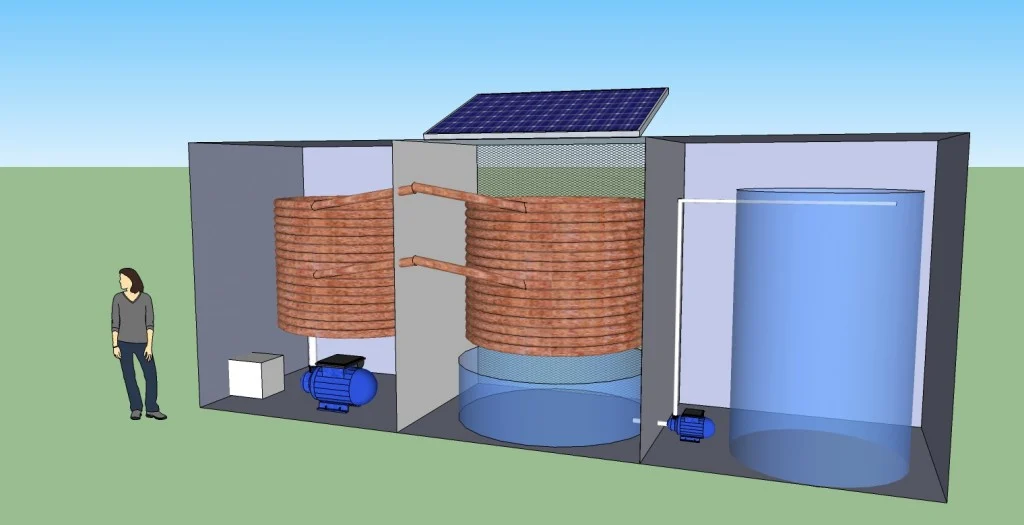
TOP VIEW DIAGRAM OF LAYOUT OF OFF GRID COMMUNITY
—————————————————————————
Stage 3: After the pilot “Open Source Community Farm Project”
VERTICAL FARM LIGHTING CONCEPT
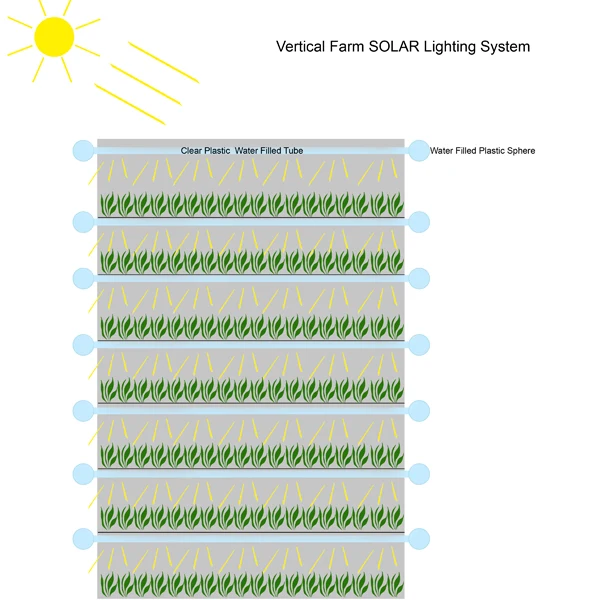
NATURAL/SUSTAINABLE BUILDING RESOURCE LINKS:
OPEN DESIGN: SUSTAINABLE LIVING & NATURAL BUILDING RESOURCE LINKS
Here is a list of resource links relating to green technology and open source information.
Open Source: http://en.wikipedia.org/wiki/Open_source
Crowdsourcing: http://en.wikipedia.org/wiki/Crowdsourcing
Crowdfunding: http://en.wikipedia.org/wiki/Crowd_funding
Sustainable Living: http://en.wikipedia.org/wiki/Sustainable_living
Open Source Ecology: http://opensourceecology.org/
Video: http://vimeo.com/16106427
Shipping Container Architecture: http://en.wikipedia.org/wiki/Shipping_container_architecture
Containerist: http://containerist.com/
Strawbale Construction: http://en.wikipedia.org/wiki/Straw-bale_construction
Green Wiki: http://green.wikia.com
Removing Institutional Barriers to Sustainability:http://oasisdesign.net/design/legalizesustainability/
Community Supported Agriculture: http://en.wikipedia.org/wiki/Community-supported_agriculture
Natural Building: http://en.wikipedia.org/wiki/Natural_building
Sustainability: http://en.wikipedia.org/wiki/Sustainability
Off The Grid: http://en.wikipedia.org/wiki/Off-the-grid
Self Sufficiency: http://en.wikipedia.org/wiki/Self-sufficiency
In-Situ Resource Utilization: http://en.wikipedia.org/wiki/In-situ_resource_utilization
DIY Ethic: http://en.wikipedia.org/wiki/DIY_ethic
Ecology: http://en.wikipedia.org/wiki/Ecology
Build Out: http://en.wikipedia.org/wiki/Build-out
Open Source Home Design Competition: http://architectureforhumanity.org/events/2010-01-15-open-source-house-design-competition
Green Power Science: http://greenpowerscience.com/
Open Structures: http://openstructures.net/
ByExample.com: http://www.byexample.com/
How to build an Open Source Community: http://www.oss-watch.ac.uk/resources/howtobuildcommunity.xml
Design Ideas Daily: http://dornob.com/
BioDiesel: http://en.wikipedia.org/wiki/Biodiesel
Bio Plastics: http://en.wikipedia.org/wiki/Bioplastic
Bio Plastic Products: http://www.cereplast.com/
Algae Biofuel VIDEO: http://www.youtube.com/watch?v=n9_-ZguuhBw
Algae Biofuel: http://en.wikipedia.org/wiki/Biofuel_from_algae
Algae fuel: http://en.wikipedia.org/wiki/Algae_fuel
Photobioreactor: http://en.wikipedia.org/wiki/Photobioreactor
Vertical Farming: http://en.wikipedia.org/wiki/Vertical_farm
Compressed Earth Block: http://en.wikipedia.org/wiki/Compressed_earth_block
Permaculture: http://en.wikipedia.org/wiki/Permaculture
AquaCulture: http://en.wikipedia.org/wiki/Aquaculture
Aquaponics: http://en.wikipedia.org/wiki/Aquaponics
Hydroponics: http://en.wikipedia.org/wiki/Hydroponics
Factor e Farm Infrastructure Buildout 2011: http://opensourceecology.org/wiki/Factor_e_Farm_Infrastructure_Buildout_2011
Factor e Farm: http://vimeo.com/19950597

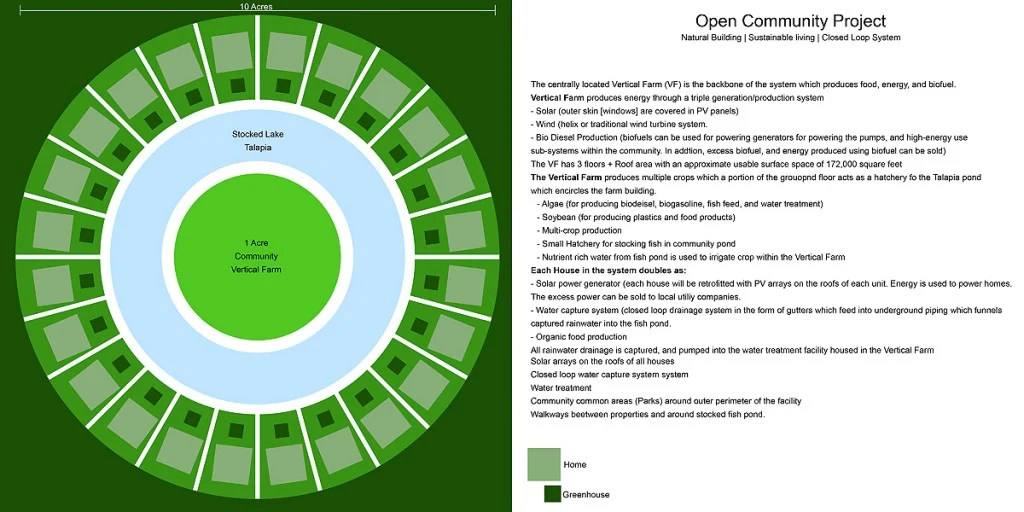
Dreaming Of An Affordable Off-Grid Environmentally Sensitive Home… Click Here! Offgridworld.com | Listen To the Red Shaman And Friends 2013
Tuesday 26th of November 2013
[…] Off Grid Community - 25,313 views […]
weneedaplan2013
Monday 21st of October 2013
i would love to do this i have so many ideas about farming like if people have pets the number 2 can be used for fertilizer not much differant than cow manure. or have some yards that have cows and some that house the chickens and some that have pigs and so on. you could even have a butcher on site in a house so it can actually be like a small community. wow the perfect life lol. maybe even private security in smart cars ran off of water or corn . i can see it now. i am actually excited about this project to bad i am in no shape or form to help out maybe the security part ex military. send me more info on price and specs and maybe we can do something.
1000 People Can Accomplish GREAT THINGS!
Sunday 28th of October 2012
[...] Read More Here [...]
30 DAYS OFF GRID!
Monday 1st of October 2012
[...] Central California. WHY? To raise awareness and gain support for our plans to build a small Off Grid Community, and to make a personal documentary about my journey off grid. To do this I am putting myself in [...]
How To Build a 40 Acre Off Grid Community (Ecovillage) For LESS Than $1 Sq Ft!
Tuesday 25th of September 2012
[...] to secure the land and go off grid, but it also dedicates a significant section of that land to the garden/farm equal to 100 square [...]